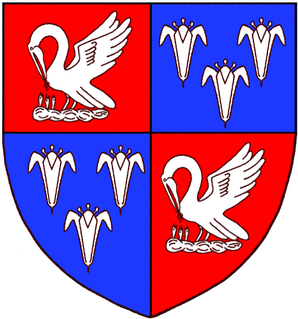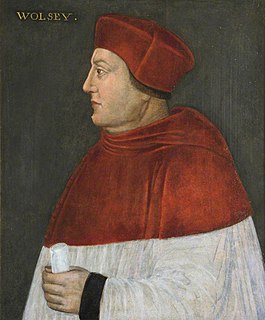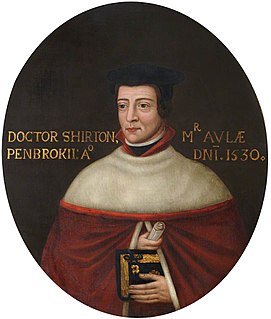Life
In 1478 Wolman was a member of Corpus Christi College, Cambridge. He also studied abroad, being noted in the Oxford register as doctor of the civil law "of an [sic] university beyond the seas". He was principal of St. Paul's Inn, in the university of Cambridge, in 1510, and was made doctor of canon law in 1512. On 31 October 1514 he was admitted an advocate, and on 9 April 1522 collated to the archdeaconry of Sudbury. In 1524 he became vicar of Walden, Essex, and on 26 July of the same year canon of St. Stephen's, Westminster. [5]

Corpus Christi College is a constituent college of the University of Cambridge. It is notable as the only college founded by Cambridge townspeople: it was established in 1352 by the Guild of Corpus Christi and the Guild of the Blessed Virgin Mary, making it the sixth-oldest college in Cambridge. With around 250 undergraduates and 200 postgraduates, it also has the second smallest student body of the traditional colleges of the University.
Wolman appears to have been resident at court in 1525, and to have been an intermediary with the king, during the absence of Thomas Wolsey, in the matter of ecclesiastical preferments. He was made chaplain to the king Henry VIII in 1526, and a master of requests in attendance at the court, an office involving membership of the king's council. On 4 July 1526 he was presented to the living of Amersham, but he continued to reside at court. [5]

Thomas Wolsey was an English archbishop, statesman and a cardinal of the Catholic Church. When Henry VIII became King of England in 1509, Wolsey became the King's almoner. Wolsey's affairs prospered, and by 1514 he had become the controlling figure in virtually all matters of state. He also held important ecclesiastical appointments. These included the Archbishopric of York – the second most important role in the English church – and acting as Papal legate. His appointment as a cardinal by Pope Leo X in 1515 gave him precedence over all other English clergy.

Amersham is a market town and civil parish within the Chiltern district in Buckinghamshire, England, in the Chiltern Hills, 27 miles (43 km) northwest of central London. It is part of the London commuter belt. Amersham is 15 miles (24 km) from Aylesbury and 8 3⁄4 miles (14 km) from High Wycombe.
On 17 May 1527 Wolsey sat at his house at Westminster to hear the pleadings in the king's divorce suit. On this occasion Wolman was nominated by the king promoter of the suit. On 5 and 6 April 1527 he took the evidence of Richard Foxe as to Henry's protest against the marriage with Catherine of Aragon. On 31 May he brought forward this evidence and adduced arguments against the dispensing power of the pope. During the proceedings Wolman acted as a secret negotiator between the king and Wolsey. His reward was a prebend in St Paul's Cathedral (25 June) and a third share of the advowson of the first canonry and prebend void in St. Stephen's, Westminster. He is frequently referred to as a canonist of authority by the correspondents of the king and of Wolsey during the divorce proceedings. He was one of twenty-one commissioners to whom Wolsey, on 11 June 1529, delegated the hearing of causes in chancery. He was one of the signatories of the address to Pope Clement VII. [5]

Richard Foxe was an English churchman, successively Bishop of Exeter, Bath and Wells, Durham, and Winchester, Lord Privy Seal, and founder of Corpus Christi College, Oxford.

Catherine of Aragon was Queen of England from June 1509 until May 1533 as the first wife of King Henry VIII; she was previously Princess of Wales as the wife of Henry's elder brother, Arthur.

St Paul's Cathedral, London, is an Anglican cathedral, the seat of the Bishop of London and the mother church of the Diocese of London. It sits on Ludgate Hill at the highest point of the City of London and is a Grade I listed building. Its dedication to Paul the Apostle dates back to the original church on this site, founded in AD 604. The present cathedral, dating from the late 17th century, was designed in the English Baroque style by Sir Christopher Wren. Its construction, completed in Wren's lifetime, was part of a major rebuilding programme in the City after the Great Fire of London. The cathedral building largely destroyed in the Great Fire, now often referred to as Old St Paul's Cathedral, was a central focus for medieval and early modern London, including Paul's walk and St. Paul's Churchyard being the site of St. Paul's Cross.
Some time after 29 August 1529, and before 8 November following, when he was elected prolocutor of Convocation, Wolman was appointed dean of Wells. In October 1531 he was incorporated at Oxford. He sat on the Committee of convocation which on 10 April 1532 received the subscription of Hugh Latimer to articles propounded to him. On the following 30 June he was presented by the crown to the rectory of High Hunger (Ongar) in Essex. [5]

Hugh Latimer was a Fellow of Clare College, Cambridge, and Bishop of Worcester before the Reformation, and later Church of England chaplain to King Edward VI. In 1555 under the Catholic Queen Mary he was burned at the stake, becoming one of the three Oxford Martyrs of Anglicanism.

High Ongar is a village and civil parish in the County of Essex, England. It is located a mile (1½ km) north-east of Chipping Ongar, 8 miles (13 km) west of Chelmsford and 6 miles (10 km) north-west of Brentwood.

Essex is a county in the south-east of England, north-east of London. One of the home counties, it borders Suffolk and Cambridgeshire to the north, Hertfordshire to the west, Kent across the estuary of the River Thames to the south, and London to the south-west. The county town is Chelmsford, the only city in the county. For government statistical purposes Essex is placed in the East of England region.
When, in October 1532, Henry VIII left England for an interview with Francis I of France at Boulogne, Wolman was one of the council exercising the royal power in London. On 19 March 1533 he was made canon of Windsor, As dean of Wells he signed the acknowledgment of the royal supremacy on 6 July 1534. He cultivated Thomas Cromwell's favour and supported the new queen Anne Boleyn. He signed a declaration, as a doctor of canon law, on the subject of holy orders in 1536. This was put forward in support of the recent religious changes, and bore the signature of Cromwell, as the king's vicegerent, at its head. When the Lincolnshire rebellion broke out, in the autumn of 1536, Wolman was appointed to act on the council of the queen Jane Seymour, during the contemplated absence of the king. [5]

Francis I was King of France from 1515 until his death in 1547. He was the son of Charles, Count of Angoulême, and Louise of Savoy. He succeeded his cousin and father-in-law Louis XII, who died without a son.

Thomas Cromwell, 1st Earl of Essex, was an English lawyer and statesman who served as chief minister to King Henry VIII of England from 1532 to 1540, when he was beheaded on orders of the king.

Anne Boleyn was Queen of England from 1533 to 1536 as the second wife of King Henry VIII. Their marriage, and her execution by beheading, made her a key figure in the political and religious upheaval that was the start of the English Reformation. Anne was the daughter of Thomas Boleyn, 1st Earl of Wiltshire, and his wife, Lady Elizabeth Howard, and was educated in the Netherlands and France, largely as a maid of honour to Queen Claude of France. Anne returned to England in early 1522, to marry her Irish cousin James Butler, 9th Earl of Ormond; the marriage plans were broken off, and instead she secured a post at court as maid of honour to Henry VIII's wife, Catherine of Aragon.
Wolman signed, in 1537, the address of convocation to the king desiring his sanction to the Institution of a Christian Man . He died in the summer of 1537, and was buried in the cloisters of Westminster Abbey. He left a sum of money for the construction of a market cross and shelter at Wells, which was erected by 1542. He also founded an exhibition at Cambridge. [5]
This page is based on this
Wikipedia article Text is available under the
CC BY-SA 4.0 license; additional terms may apply.
Images, videos and audio are available under their respective licenses.














